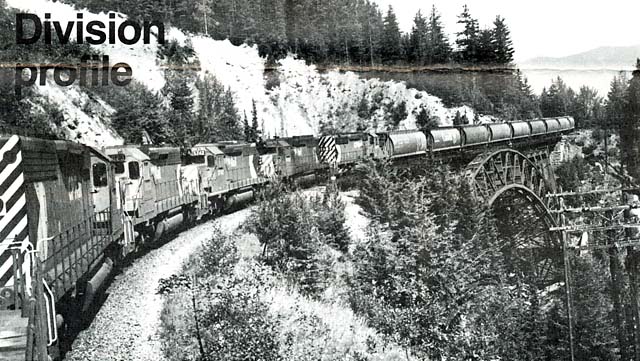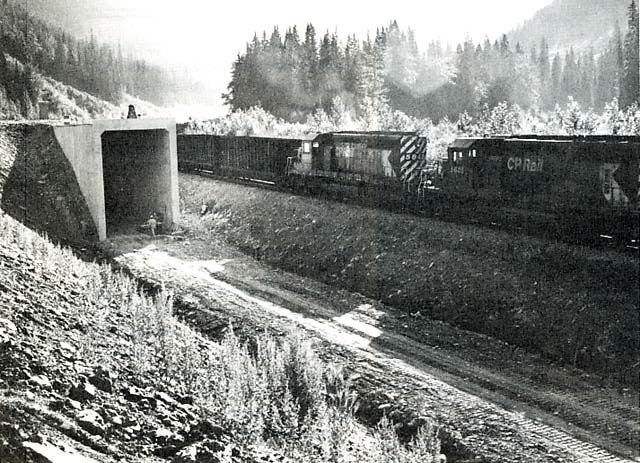|
1982-1984 |
Revelstoke Crews Match Nature Blow for Blow Revelstoke - For nearly a century this mountainous region of British Columbia has been a proving ground for railway apprentices and veterans alike. Torrential rains and thunderous snowstorms can wreak havoc for the railway here. At any time of the year employees can be called upon to slog long hours in miserable weather to repair damages caused by mudslides, avalanches, and rain-swollen rivers. The steep grades and the numerous long, heavy, trains that wind through the division on the way to domestic and export markets daily put the handling skills of Revelstoke's train crews to the test. The Rogers pusher station, 60 miles (96.5 kilometres) east of here, is manned 24 hours a day by six locomotive engineers and other support staff who provide additional motive power to consists faced with the nine-mile (14.5 kilometre), 2.2 percent climb to Stoney Creek. The climb takes about 45 minutes at a snail's pace. "The officers, track crews, people who operate trains, everyone on the division tend to be high-calibre individuals. If they aren't that way when they arrive, they tend to develop into that kind of person as they engage themselves in the work of the division," says Revelstoke Division Superintendent Jack White. UNPREDICTABLE By and large the division has a younger group of employees, "employees who rise to the problem and enjoy the challenge," he adds. Their greatest foe is Mother Nature. "We get about 300 to 500 inches (762 to 1,270 centimetres) of snow per year through the Rogers Pass area and this leads to problems of snow slides in the winter and mudslides, high water, and wash-outs in spring and early summer," says Mr. White. "It all depends on how orderly nature allows the snow to melt, and believe me, nature is very unpredictable." Mr. White points to this summer's tussle with the Illecillewaet River which, when unable to accommodate an unseasonably heavy rainfall, knocked out the main line on the mountain subdivision for nine days. The subdivision stretches 125 miles (200 kilometres) from Field to Revelstoke and before service could be restored 34 trouble spots, eight of them major, had to be corrected. Reflecting on the ordeal, the veteran railwayman says it was "like one long day, a long day of bad dreams." Word of the trouble came in at a 1 a.m. telephone call 12 Jul 1983 but Mr. White says he knew it was really serious when he fetched a glass of water after hanging up. "We get our drinking water from Greeley Creek and the water was coming out muddy. I knew we were in trouble." During the previous 24 hours, 3.5 inches (nine centimetres) of rain had fallen on the area and snow at the high elevation, which had not melted in the spring, was beginning to move down as well. SOMETHING LEARNED By noon, Mr. White, John Linn, assistant general manager, Bill Tripp, deputy regional engineer, and Karl Jansens, division engineer, were surveying the damage by helicopter. "The scene looked like a model railway. Everything was neat and tidy except for locations of devastation," Mr. White recalls. "I thought we'll be lucky to get this line back in operation in under a month." "It was as though nature was saying we didn't belong in the Illecillewaet valley and her persistence made us recognize how fragile we are." In retrospect, Karl Jansens says the washout at Mileage 108.7 was the worst. "Initially, it was 400 feet (122 metres) long. I stood and watched it for a while, trees were falling as the banks were eroding. In two hours, the spot was a wash-out 800 feet (244 meters) long." Assistant Superintendent Cecil Darby says, "It's a credit to our people that we didn't have the injuries we could have had. One thing for sure, I hope we will never have anything like this again." Mr. White says the Revelstoke Division, with all its challenges, can teach every railwayman something. "Everyone who works for the railway should spend some time in this division. Our people can handle any situation. They are often called to do just that," he says.
This CP Rail News article is copyright 1983 by the Canadian Pacific Railway and is reprinted here with their permission. All photographs, logos, and trademarks are the property of the Canadian Pacific Railway Company. |


